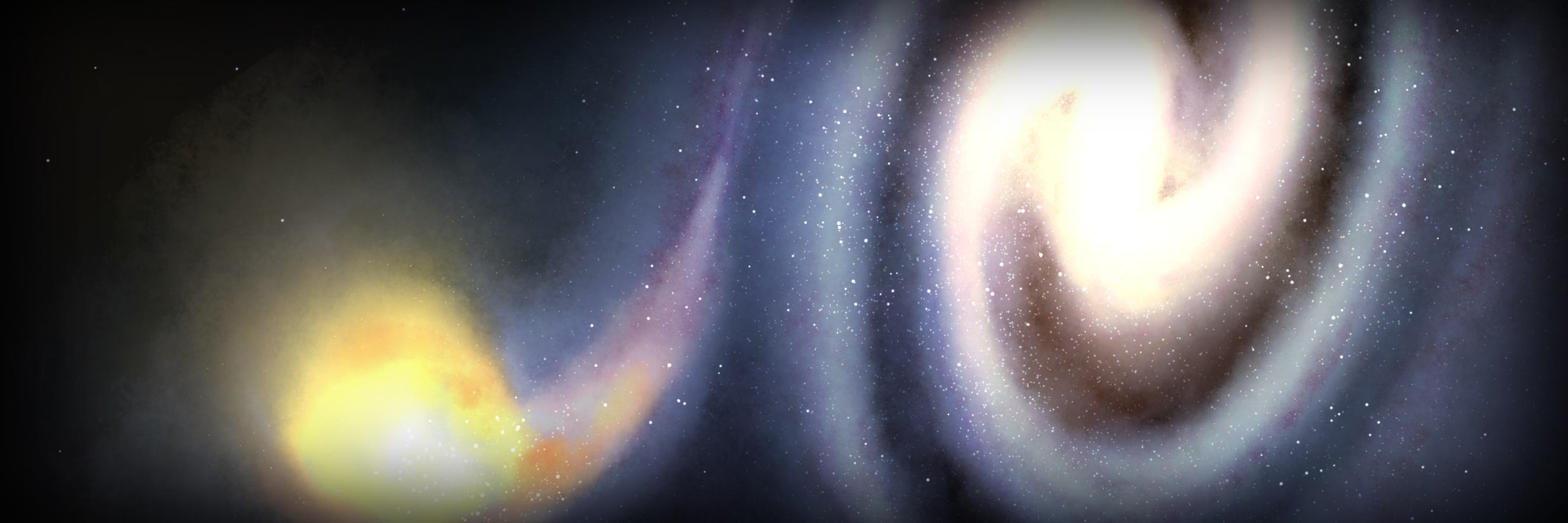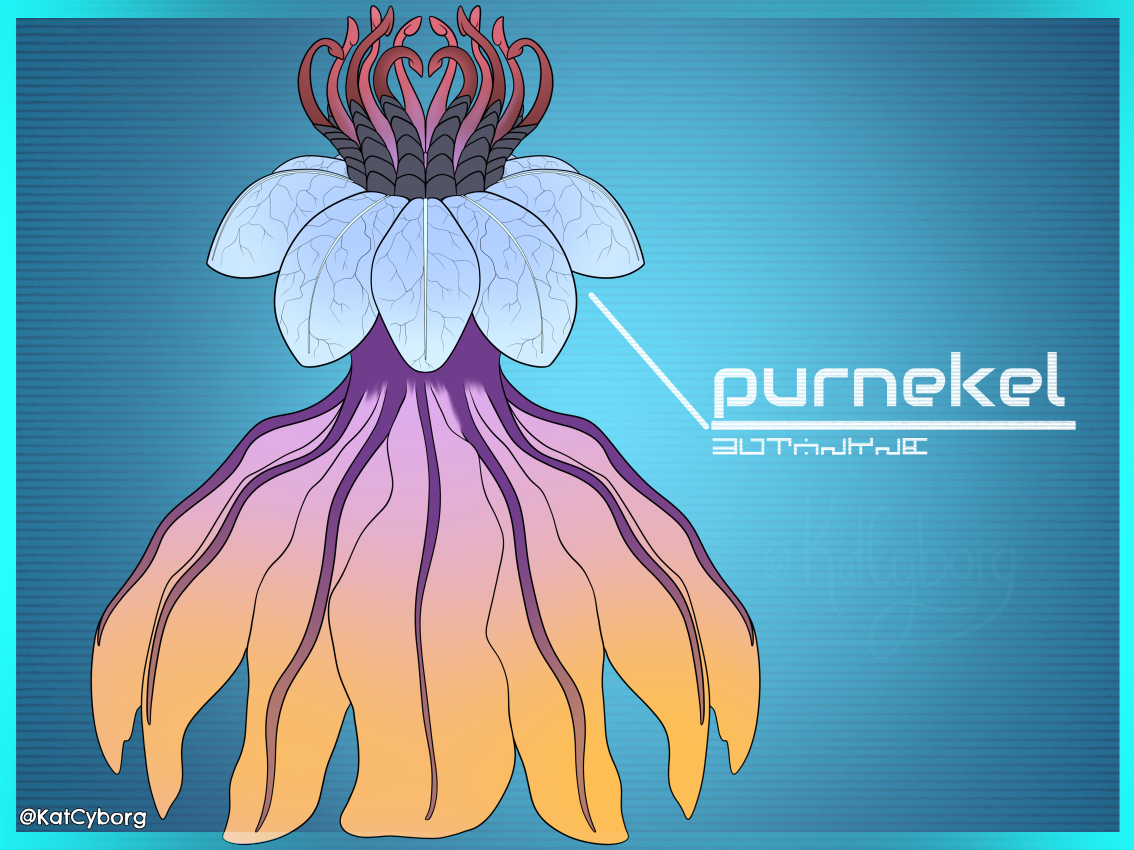purnekel (Per-Neck-Kell)
Overview
Purnekels are space-dwelling creatures that are usually found among the asteroids of star systems. They are peaceful creatures and rarely interact with other living beings except for members of their own kind. They do not eat anything other than the minerals they can find in their home systems, usually in asteroids and other space debris and possibly the radiation from nearby stars (at least, that is the theory, they are remarkably difficult to study in any great detail, as bringing them into oxygenated environments seems to kill them instantly). They are a favourite prey of young Talbek - one purnekel alone will not feed most Talbek, but they are known to travel in large groups and can be quite the filling meal for a talbek hatchling. On rare occasions, groups of purnekels can be seen following larger Talbek and feeding off the debris it leaves behind.Basic Information
Anatomy
Purnekels look like some kind of translucent flower. They have at least two rings of “fins” which they seem to be able to use to move through space (though no one is entirely sure how this works, since the fins alone shouldn't be able to propel them in the emptiness of space). The top row are usually blue in colour, while the larger second row is usually purple and fades to orange. At the top of their bodies, above the top ring of fins, they have 12 tendrils which they usually have folded in to defend their mouth. The outside of these tendrils are armoured, and the inside of their mouths are a bright pinkish-purple colour. They can have a small amount of variation in colour, for example, some purnekels have pink or even red secondary fins, and green or yellow primary fins, but most keep to their standard colour scheme.
Biological Traits
It is thought that purnekels grow throughout their lives, and their size depends on how much food they consume, so averages are a very vague estimate. The largest purnekel ever discovered was nearly 100m from top to bottom, but there are also plenty that are only about 1m tall
Ecology and Habitats
Purnekels can be found in most star systems, but seem to show up more in uninhabited systems where little to no other life can be found. They can usually be found in the asteroid belts and ort clouds of the system, and seem to prefer asteroids with higher quantities of minerals like platinum. Interestingly, no one is entirely sure how they travel between systems. They are much too slow to do this on their own, they would die of starvation before reaching another star, but they are so common that its considered highly unusual not to see them in uninhabited star systems - so much so that the Kepek use their presence to screen for potential new systems to establish colonies. The leading theory is that they somehow attach themselves to large talbek, and release when they find a suitable home, but no one has ever observed this happening directly.
Biological Cycle
purnekels start life as eggs. A parent will usually lay a few hundred at a time, which will drift freely in space. purnekels have an extremely low survival rate at this phase, with only 10-50 eggs from each clutch surviving long enough for the babies to be born. Rather than breaking through a shell to hatch like most, the outside of the purnekel's egg remains a part of them. The egg unfolds when the baby is fully developed, and the “shell” becomes the primary ring of fins.
The babies reach full maturity after 2 bektep-orbits, and will spend the majority of their lives searching for food and recourses, usually wandering the star system to do so.
In their last 5 years, they will begin to look for mates. All purnekels are hermaphroditic, so they can successfully mate with any other individual they come across and produce children. They will usually be successful in finding at least one mate, and can produce up to 3 batches of eggs before they “die”.
Officially, purnekels only live around 25 Bektep-years, but much like some jellyfish, they seem to be able to revert and regenerate when they sustain enough damage, or start to deteriorate from the exposure to radiation. once they reach the end of their lifespan, they will begin the process to revert back into their egg form and the cycle will begin again. The more times the purnekel has successfully completed this cycle, the more fins they will have in their primary ring. Particularly old purnekels may even develop a second or third set of primary fins. These eggs of multi-cycle surviving purnekel are called cycled-eggs.
Additional Information
Domestication
The Kepek have successfully “domesticated” a significant number of purnekel schools who inhabited the Vaxa-Bakrud System and the asteroid field around the Bektep Space Station - though it somewhat stretches the definition of domestication.
The Bektepi Kepek were able to make an artificial asteroid belt the orbits around their space station. The region of space the station was established is extremely barren, and so the asteroid belt attracted the nearby schools who were fairly desperate for food. The astrofarmers then placed trackers on the purnekel and will go out to meet them daily. They ensure they have not wandered into a baren spot (or created a barren spot by eating too quickly) and if they have, the farmers will guide them to a better location. They also harvest any eggs the Purnekels may lay and gather any shed secondary fins dropped. The fins are used in the manufacturing of Kepek spacesuits, and while they can be replicated in the lab, suits made from the genuine material seem to be more resilient, though scientists can't quite determine why.
Purnekel farms usually consist of multiple flocks, each containing up to 100 individuals. The farmers will often have designated groups of purnekel who are kept solely to harvest eggs and shed fins from, while others are bred specifically to harvest cycled-eggs (see biological Cycle for more info). The laws surrounding cycled eggs are extremely strict, the purnekel has to reach the end of their life cycle naturally, it can not be induced by the farmed inflicting harm to the purnekel, and so any farmers who are involved in the production of cycled eggs must record their interactions with the flock at all times to ensure no harm comes to the creatures.
some farmers, to ensure their flock doesn't end up wandering too far, will set up energy fencing around a section of the asteroid belt. This creates what is essentially a space paddock, however, this method has fallen out of favour recently. Many fear fencing the purnekel not only causes them undue stress (as they don't seem to be able to detect the fencing, and so just run into it if they reach it's edge) but makes them potential targets for predators like the talbek. Talbek rarely come so close to the Bektep Space Station, but no one wants to risk attracting one if it can be avoided, as the adults can be incredibly destructive.
attempts to replicate this farming system elsewhere in the galaxy have failed spectacularly. The Purnekel elsewhere seem completely disinterested in interacting with the Kepek. A few smaller-scale farms have been successfully established around other space stations and in a few star systems, but for the most part, the Purnekel farming industry is a unique industry to the Bektep Space Station. This doesn't mean, however, that the Kepek haven't found other uses for the wild Purnekel. Wild purnekel are a good initial indicator to the Kepek Commonwealth that a star system is uninhabited and suitable for colonisation. This method isn't 100% of course, but it has proven to be a good indicator of points of interest for many thousands of bektep-orbits
Perception and Sensory Capabilities
purnekels have no ears, nose or tongues (unless you count their tendrils) and so are completely deaf and unable to smell or taste anything. They do, however, appear to have some amount of vision though, though no one has ever found eyes (or similar sensory organs) on them. one theory is that their primary ring of fins might have some kind of light sensitivity, it might not necessarily be true vision, but when exposed to bright light, they will fold the fins up and over themselves to shield the top sides of them. They also have some amount of colour vision, as astrofarmers are able to train them by changing the colour of their ships to signify different things, e.g. green means “follow, I will guide you to food” while red signifies “danger - flee”. They also seem to have a sense of touch, as the tendrils around their mouths will recoil if touched, as do their primary fins. Their secondary fins, however, do not react at all when touched.
Origin/Ancestry
unknown
Lifespan
25 Bektep-Orbits
Age of Maturation
2 Bektep-Orbits
Average Height
5m
Geographic Distribution
Remove these ads. Join the Worldbuilders Guild











Comments